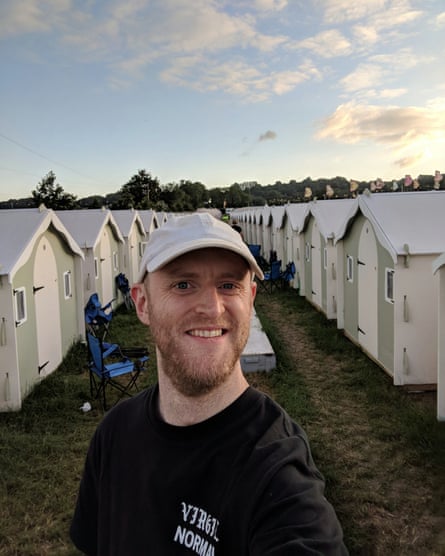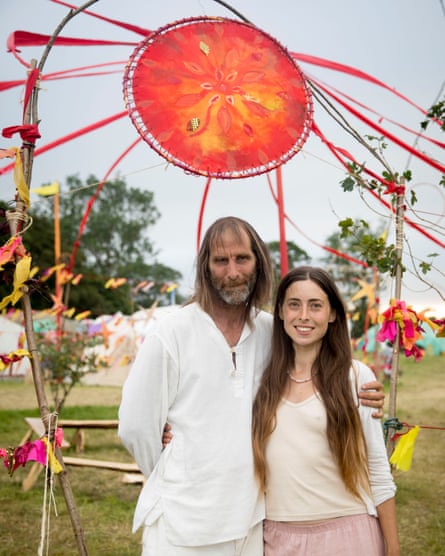Drenched in sweat, dancing inside a cage to propulsive disco-house surrounded by toned young men, the thought suddenly hits me: we’ve got to make a newspaper tomorrow.
This sort of thing happens all too easily at Glastonbury – a tequila toast to the headliner turns into a wander to a dance tent, and before you know it you’re in a gay club and the sun is well on the way back around again. All fine if you’re a punter, but if you’re a journalist at Glastonbury it means a lot of sleep deprivation followed by determined rehydration.
The Guardian is proud to be the media partner at Glastonbury: a cultural event unlike any other on earth, which we try to cover the length and breadth of each year. For 2019, I invited ahugely varied team of journalists, not just to cover the music, but to give a sense of Glastonbury being a teeming mass of humanity – a 200,000-strong temporary city filled with political wrangles, amazing outfits, declarations of love, and really good Thai curry.

In the weeks leading up to the festival, we have to arrange the delivery of two portable cabins to work in, complete with all the technology needed for our coverage on site (well, some decent wifi and plug sockets). Our commercial team work to install sales points across the site where you can buy the print newspaper during the weekend, while the team on the Guide supplement bring together a mini-version for the festival, featuring listings and previews. We also create a special edition of our Film & Music section to be published on the Friday of the festival, so we work up a series of feature ideas for these about three months before: this year we had interviews with Pyramid stage performers Vampire Weekend and Carrie Underwood, and a feature exploring why the Killers’ Mr Brightside would probably be the biggest singalong of Glastonbury weekend. (My extremely noisy and shaky camera footage of their subsequent performance thankfully proved this theory to be correct.)
Team Guardian arrives on site in dribs and drabs. Members of the commercial team arrive as early as Monday, while the first editorial staff get there on Wednesday morning, as festivalgoers spend the morning looking baffled at tent poles. Arts correspondent Lanre Bakare and photographer Alicia Canter were the first on site this year, writing what are called “curtain-raiser” stories about the gathering anticipation – and, of course, the likely weather. On Thursday at the William’s Green stage, freelance writer Dorian Lynskey introduced a Guardian screening of the Aretha Franklin concert film Amazing Grace.
Our coverage began in earnest on Friday, when the music begins along with our liveblog that follows all the action as it happens. This runs from 11am until midnight each day, providing a constant stream of music reviews, photography and mini-features. This year we had I’m In Control, a homage to Pyramid stage performer Janet Jackson and her song Control, asking Glastonbury-goers what they would do if they were in charge of the festival; and the Glastonbury People’s Assembly, where we quizzed punters on what they’d do to solve Brexit (famously, the vote took place during Glastonbury 2016, casting a very strange mood across one of the rainiest years ever). We also had the Guardian’s senior fashion writer Lauren Cochrane picking out the best looks in the field, and food writer Felicity Cloake on a quest to find the tastiest food. And critics including Laura Snapes, Ammar Kalia and Gwilym Mumford sent back reviews and pictures of bands from the field – all of it coordinated via a WhatsApp group, somewhat temperamentally given the patchy phone reception.

Meanwhile, our arts editor, Alex Needham, headed the production of an entire issue of our G2 print section from the site. Again, this was planned weeks in advance, although the nature of newspaper production means that features were being swapped in and out just hours before our Sunday mid-afternoon deadline. This was the most ambitious and features-packed G2 yet, with star interviews (Mark Ronson, Lewis Capaldi, Nadine Shah) alongside stories that show off what a joyously bonkers place Glastonbury is. A personal favourite was from Elle Hunt, dispatched to find someone who hadn’t watched any music all weekend and hear about their festival experience. I was worried she might not find anyone – in the end she found a couple who ran a gong bath tent in the Healing Fields who had been going for 15 years and had seen just one performance that entire time: Leonard Cohen in 2008. Other highlights included testing out dating apps, Michael Segalov’s account of bringing his dad to Glastonbury (replete with plenty of drag queens), and a Marie Kondo-inspired mission to find the site’s tidiest tent. Our multimedia team made a mini-documentary presented by Owen Jones, as he sought to find out whether Glastonbury is really the activist hub its reputation suggests; they also produced daily stories for the Guardian’s Instagram feed.
Each evening, we handed the reins of the liveblog to Guardian writers in London – Tim Jonze and Michael Hann – giving me an opportunity to gawp at the sunset from the Park stage, and see some of the headliners. As brilliant as the Killers were – in the sweetest of spots between rock’n’roll swagger and crooning Vegas showmanship – Stormzy was the moment of the weekend for me: a milestone in the progression of black British culture from the margins to the mainstream.
Then it’s back to the cabin, to pick over the headliners with chief critic Alexis Petridis, who filed reviews with admirable speed. Once published, it’s then time to take stock of the photography from the day with picture editor Karin Andreasson, and build beautiful immersive galleries to be launched first thing the following morning. It’s gone 1am each day by the time this is all put to bed, but the exhilaration of bringing together the day’s work is weirdly uplifting. The angel on your shoulder that tells you to go to bed and preserve yourself for the following day is dropkicked by the devil on the other. Sure enough, I end up in a cage dancing to propulsive disco-house.
All in all, we published 79 stories across the entire week, plus a handful more in the aftermath, and broke our all-time Glastonbury traffic record set in 2017. Ideas are already being passed around for coverage of next year’s festival, which is Glastonbury’s 50th anniversary. We’re expecting the starriest musical lineup yet – and another bout of extreme sleep deprivation.









